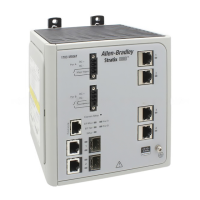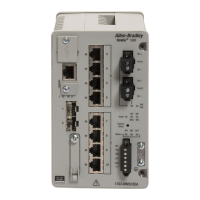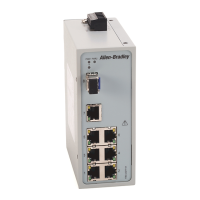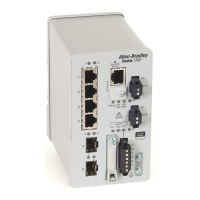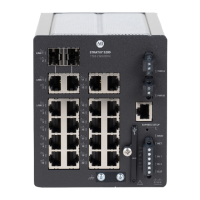Rockwell Automation Publication 1783-UM003G-EN-P - December 2012 63
Manage the Switch via the Device Manager Web Interface Chapter 3
Configure VLANs
Use the VLANs dialog box to create, modify, and delete VLANs. To display this
dialog box, choose Configure>VLANs from the Device Manager Web interface
menu.
The default VLAN ID is 1 and the name for the management VLAN is default.
The default VLAN alone might be sufficient based on the size and requirements
of your network. We recommend that you first determine your VLAN needs
before creating VLANs.
To create a VLAN, you must give the VLAN a name and a unique ID number.
You can create up to 255 VLANs.
You can modify the name of a VLAN but not its number. You cannot modify or
delete the default VLAN.
CIP VLAN Settings
Setting description
CIP VLAN The VLAN on which CIP will be enabled. The CIP VLAN can be the same as the management VLAN or you can isolate CIP
traffic on another VLAN that is already configured on the switch. Change the CIP VLAN settings only if you want CIP traffic
to be on a separate VLAN from the management VLAN. Existing settings might have been set during the initial setup (done
through the Express Setup process; refer to Set Up the Switch Initially with Express Setup on page 15).
The default ID is 1. The default name for the CIP VLAN is default.
IP Address The IP address is a unique identifier for the switch in a network. The format is a 32-bit numeric address written as four
numbers separated by periods. Each number can be from 0...255.
If the CIP VLAN is different from the management VLAN, you must specify an IP address for the CIP VLAN.
Make sure that the IP address that you assign to the switch is not being used by another device in your network.
Subnet Mask List The subnet mask is the network address that identifies the subnetwork (subnet) to which the switch belongs. Subnets are
used to segment the devices in a network into smaller groups. The default is 255.255.255.0.
If the CIP VLAN is different from the management VLAN, you must specify a subnet mask for the CIP VLAN.
The following settings (except for Host Name) will reset if power to the switch
is lost. To maintain these settings, connect the switch to a Network Time
Protocol (NTP) server by using the command-line interface.
Optional Settings
Setting Description
Host Name A name for the switch. The name can have up to 31 alphanumeric characters. The name cannot contain a ?, a space, or a
tab. The default is Switch.
We recommend entering either the name, the location, or the IP address of the switch to help identify the switch during
monitoring or troubleshooting.
System Date The date that the switch read from the network management station or that was manually set during the initial setup. If
you change the date, the change takes effect immediately after you click Submit.
System Time The time that the switch read from the network management station or that was manually set during the initial setup. If
you change the time, the change takes effect immediately after you click Submit.
Time Zone This is the time zone that the switch automatically read from the network management station or that was manually set
during the initial setup. If you change the time zone, the change takes effect immediately after you click Submit.
Daylight Savings Time Automatically checked only when the selected time zone is in the U.S., Europe, or Australia. Unchecked for all other time
zones.
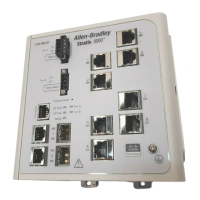
